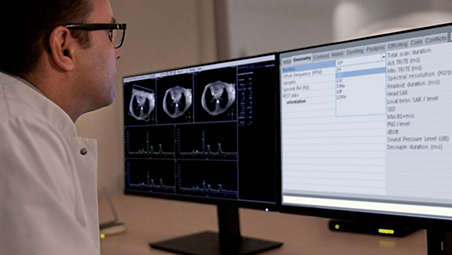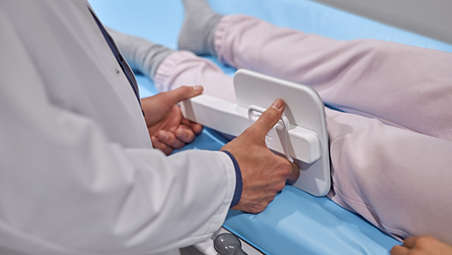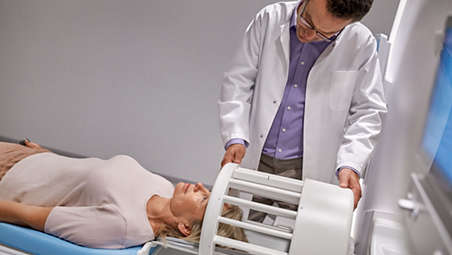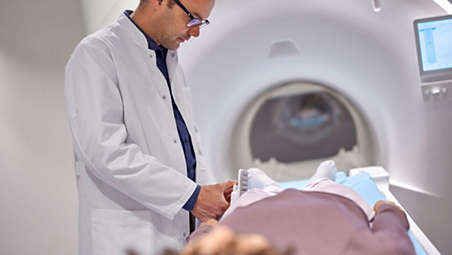- Nucleus -just a scan parameter
-
Nucleus is just a scan parameter
Rather than a complex process, multi-nuclei studies have become a simple protocol that can be “dragged and dropped” into your ExamCard. How much simpler can it be? The nucleus is just a scan parameter like any other sequence parameter. A single ExamCard can be used to run both proton and non-proton imaging and images can be checked on the console before the patient even leaves the room. - Workflow - Proton imaging
-
Workflow does not differ from proton imaging.
We’ve made it easy for your operation, with a seamless integrated workflow for multi-nuclei image acquisition, spectroscopy, reconstruction, and viewing. Reconstruction and viewing of non-proton images or spectra, as well as the process for sending the data to PACS is fully integrated, so workflow does not differ from proton imaging. Easy export of multi-nuclei data is supported for enhanced DICOM, SPAR/SDAT, and XML-REC. - Brain exams, without switching coils
-
Brain exams, without switching coils
In addition to a seamless user interface, the dual tuned head coils from <b><i><i>RAPID biomedical</i></i></b> enable brain exams, including acquisition of proton and other nuclei, without switching coils. This allows you to schedule your multi-nuclei studies as part of your clinical exam time slots. A full brain study, including both proton (1H) and sodium (23Na) imaging can be completed in 30 minutes¹, all organized in one ExamCard using the same dual tuned head coil. A sodium (23Na) brain exam can be completed in less than 15 minutes². - Improved SNR - Flex coils
-
Improved SNR with transmit-receive flex coils
Transmit-receive flex coils are available for carbon (13C), phosphorus (31P), and sodium (23Na) scans. The ExamCard interface immediately recognizes these multi-nuclei coils. A sodium (23Na) knee exam can be as fast as 15 minutes³. Improved SNR and simplified spectra⁴ can be achieved for phosphorus (31P) and carbon (13C) spectroscopy by combining body coil decoupling, with the transmit-receive surface coils.
Nucleus is just a scan parameter

Nucleus is just a scan parameter

Nucleus is just a scan parameter
Workflow does not differ from proton imaging.

Workflow does not differ from proton imaging.

Workflow does not differ from proton imaging.
Brain exams, without switching coils

Brain exams, without switching coils

Brain exams, without switching coils
Improved SNR with transmit-receive flex coils

Improved SNR with transmit-receive flex coils

Improved SNR with transmit-receive flex coils
- Nucleus -just a scan parameter
- Workflow - Proton imaging
- Brain exams, without switching coils
- Improved SNR - Flex coils
- Nucleus -just a scan parameter
-
Nucleus is just a scan parameter
Rather than a complex process, multi-nuclei studies have become a simple protocol that can be “dragged and dropped” into your ExamCard. How much simpler can it be? The nucleus is just a scan parameter like any other sequence parameter. A single ExamCard can be used to run both proton and non-proton imaging and images can be checked on the console before the patient even leaves the room. - Workflow - Proton imaging
-
Workflow does not differ from proton imaging.
We’ve made it easy for your operation, with a seamless integrated workflow for multi-nuclei image acquisition, spectroscopy, reconstruction, and viewing. Reconstruction and viewing of non-proton images or spectra, as well as the process for sending the data to PACS is fully integrated, so workflow does not differ from proton imaging. Easy export of multi-nuclei data is supported for enhanced DICOM, SPAR/SDAT, and XML-REC. - Brain exams, without switching coils
-
Brain exams, without switching coils
In addition to a seamless user interface, the dual tuned head coils from <b><i><i>RAPID biomedical</i></i></b> enable brain exams, including acquisition of proton and other nuclei, without switching coils. This allows you to schedule your multi-nuclei studies as part of your clinical exam time slots. A full brain study, including both proton (1H) and sodium (23Na) imaging can be completed in 30 minutes¹, all organized in one ExamCard using the same dual tuned head coil. A sodium (23Na) brain exam can be completed in less than 15 minutes². - Improved SNR - Flex coils
-
Improved SNR with transmit-receive flex coils
Transmit-receive flex coils are available for carbon (13C), phosphorus (31P), and sodium (23Na) scans. The ExamCard interface immediately recognizes these multi-nuclei coils. A sodium (23Na) knee exam can be as fast as 15 minutes³. Improved SNR and simplified spectra⁴ can be achieved for phosphorus (31P) and carbon (13C) spectroscopy by combining body coil decoupling, with the transmit-receive surface coils.
Nucleus is just a scan parameter

Nucleus is just a scan parameter

Nucleus is just a scan parameter
Workflow does not differ from proton imaging.

Workflow does not differ from proton imaging.

Workflow does not differ from proton imaging.
Brain exams, without switching coils

Brain exams, without switching coils

Brain exams, without switching coils
Improved SNR with transmit-receive flex coils

Improved SNR with transmit-receive flex coils

Improved SNR with transmit-receive flex coils
